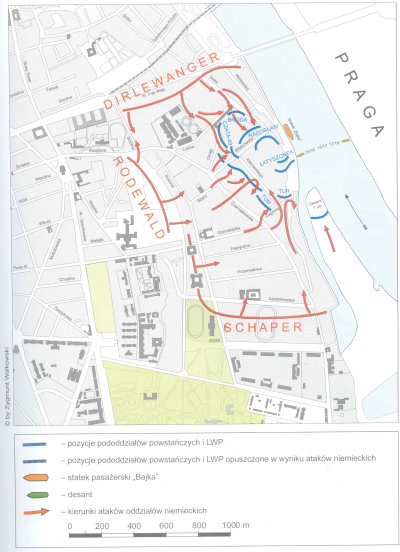
A military map presenting the fights for Czerniakow 16-23.09.1944 ("Powstanie Warszawskie" W. Bartoszewski)
The soldiers of Czerniakow
The course of events
Powisle Czerniakowskie (literally near-the-Vistula Czerniakow), which during the Warsaw Uprising was called Upper or Near Czerniakow, was delineated by the overpass of the Poniatowski Bridge in the north, Lazienkowska Street in the south, the Vistula embankment in the west and the bank of the Vistula in the east. As far as the organizational structure is concerned, it was region II, sub-district I of Srodmiescie (the City Centre) in the District of Warsaw of Armia Krajowa (the Home Army).
At 17.00 hours, August 1, the insurgents from Czerniakow moved into an open attack to liberate Warsaw from the German occupation. Unfortunately, during these initial fights they did not manage to seize the major buildings in that area garrisoned by the Germans. These buildings included the premises of the Sejm (the lower chamber of the Polish Parliament), the National Museum, the WKS Legia stadium and the German outpost situated at the western end of the Poniatowski Bridge, among others.
Due to the failure of the first attack, in the night of 1-2 of August, some of the units from Czerniakow withdrew to Kabaty Forest, and other units retreated deep to the initial positions.
In the night of 7-8 of August, Captain "Kryska", Zygmunt Netzer, together with 24th WSOP Company of "Narew" Battalion arrived at Czerniakow. "Kryska" took command of all the forces from that area and formed group V "Kryska". He also reorganised subordinate forces and created "Tum" and "Tur" Battalions.
In the nights of 3-4 and 4-5 of September, in two airdrops, insurgent units of the "Radoslaw" Group, which were under Lieutenant-Colonel "Radoslaw's" (Jan Mazurkiewicz) command, were sent to Czerniakow. At that time, the reinforced group, together with other units, consisted of 500 to 600 soldiers who formed the battalions of "Broda"[Beard] (former "Zoska" [Sophie] and "Parasol" [Umbrella] Battalions) and "Czata" (former "Czata 49" and "Miotla" [Broom] Battalions).
On the morning of September 16, 1st battalion of 9pp (9th infantry regiment) of 3DP (3rd infantry division), which belonged to General Berling's Army, made a crossing to Czerniaków. Although the soldiers crossed the Vistula right to the area that was under the insurgents' control, the arrival of new forces, which occurred during the following nights, had no major impact on the defense of Czerniakow. The Germans were also reinforced and the strategic initiative was still in their hands.
Heavy fights took place up to September 23. On the morning of that same day, the German units finally captured two remaining buildings in Czerniakow.

A military map presenting the fights for Czerniakow 16-23.09.1944 ("Powstanie Warszawskie" W. Bartoszewski)
Profiles of the defenders
Janina Błaszczak, a second lieutenant, a commander of 3rd Romuald Traugutt mortar company.
Retired Lieutenant Colonel Janina Wolanin, née Błaszczak, was born on October 5, 1924 in Kovel, Volyn Oblast. She was one of the two children in Mr and Mrs Błaszczak's family. Her father, a legionary, fought under Jozef Pilsudski's command. After Polish-Soviet War, he took up residence in Volyn as a military settler. He worked on voluntary basis for Pilsudczycy there, which was the cause of him being beaten by the Ukrainian death squads in 1939. He died in unexplained circumstances.
After the onset of the Second World War, Janina and her whole family were deported to the Ural Mountains region in February of 1940. At the age of 17 she worked hard at clearing forest. When the news about the forming of Berling's Army reached Siberia, she went to Seltsy on the Oka river in August of 1943, and there she joined a women's battalion.
At the turn of 1943-1944, Janina underwent military training summarily (it lasted five months) in the Infantry School in Ryazan, where she was promoted to the rank of second lieutenant. She graduated the school as a top student (out of 700 cadets, she was third on the list), which made her a commander of male mortar company. (It was the largest unit on the front line in the Second World War where a woman-officer of the Polish Army was in command.)
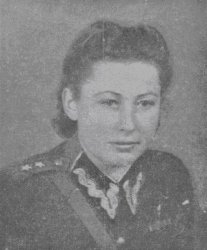
2nd Lt Janina Blaszczak (1946)
She headed for the front as a member of 3rd Romuald Traugutt Infantry Division. She took part in fighting in warecko-magnuszewski bridgehead as well as in the Warsaw Uprising in Czerniakow area, in the course of which she was wounded on September 21, 1944. She was wounded again while she was making an attempt to evacuate to the other side of the river. Declared to have been killed in action, she was decorated posthumously with the War Order of Virtuti Militari of V Class (which she received in person after the war).
As she suffered severe wounds the Germans took her prisoner and transported to hospital in Skierniewice, from where she was led out in secret by orderlies working in the underground for AK (the Home Army). For several subsequent months she has been sheltered by a railwayman's family in Skierniewice. She was cured there and stayed until February 1945.
In the years 1944-1946 she was a lecturer in an officers' school in Lodz, where she gave classes in weapon handling. This was also the place where she met her future husband, Jozef Wolanin, whom she married in 1946. That same year she was demobilised. Janina gave birth to two children and settled in Zielona Gora in 1951. Later on she worked as an economist and at the same time she did some voluntary work and took an active part in veterans' movement.
The mortar company and their commander, Second Lieutenant Janina Blaszczak, crossed to Czerniakow in the night of 15-16 September 1944. Unfortunately, they managed to rescue 4 mortars only; the remaining part of the hardware and its support sank during the crossing. A female officer, and a commander of male company, caused a sensation among insurgents.
This is the account of the first contact with Second Lieutenant Blaszczak given by a soldier of "Zoska" Battalion - Andrzej Wolski "Jur": "The time is soon. Armour-piercing rifles, heavy machine guns, they are indeed old Maxim guns but they blast away, even anti-tank cannons, and plenty of people. Soldiers, major officer, the captain of artillery reconnaissance, two radio stations, telephonists, lads with Russian automatic pistols, and loads of ammunition. And the girl - the officer."
The mortar station was situated at Solec Street, behind the headquarters of 9 pp. From there, Second Lieutenant Blaszczak fired the German positions at Czerniakowska Street in daylight, and at night-time she fired the barricades along the riverbanks in order to reinforce the defence of the shore and to support the evacuation of the injured. When the German offensive threatened the staff of 9 pp directly, the continuous fire from the mortars of 3rd company halted the enemy. On the roof of the building at 41 Solec Street an observation point for correcting mortar fire was located.
Due to the unsuccessful attempt to get the all forces of 3 DP cross the river, the isolated insurgent units and units of 9 pp fought only in order to survive. Mortars without ammunition became useless, and the 3rd company fought with only carbines since then. Janina Blaszczak led the action to defend the barricade.
Henryk Baczko wrote in his book about the fighting in Czerniakow as follows: "They fought not only with bullets but also with butts and fists. Anyone who saw Second Lieutenant Blaszczak at that time, with fair hair flowing in the wind, leading her lads to counter-attack, or throwing grenades, will never forget this sight. It seemed as if a Greek goddess descended on the bank of the Vistula to defend the beautiful work of art."
Because she was wounded twice and owing to the broken resistance of the bridgehead as well as the failure of evacuation across the Vistula to Praga, Second Lieutenant Janina Blaszczak was taken prisoner by the Germans.
The German report from September 23 1944 said: " When the resistance at the last house in the southern encirclement in Warsaw was fought, 82 Polish legionaries, 57 soldiers of AK [...] were taken prisoners. Besides, there were 35 dead bodies. There is also a Polish woman among the prisoners-of-war, who was trained as a platoon commander in Ternopil".
Stanisław Komornicki "Nalecz", during the fights in Czerniakow he was an officer cadet and a commander of an assault platoon in "Tum" Battalion of AK.
A retired Major-General, Stanislaw Komornicki, was born on July 26, 1924, in Warsaw. He attended Prince Jozef Poniatowski Gymnasium in Zoliborz and was a member of 71 Warszawska Drużyna Skautów [71st Warsaw Troop of Scouts].
In 1940 he was sworn in Związek Walki Zbrojnej (Union of Armed Struggle) - later AK, and participated in the training of Szare Szeregi (Grey Ranks) and of "Baszta". He took an active part in the operations of Wawer organization. In the course of the Warsaw Uprising he was in command of an assault platoon of "Rog" [Horn] Group which fought in the Old Town (where he was wounded), in Powisle, and in Czerniakow.
After an unsuccessful attempt to fight his way to Śródmieście [the City Centre], he crossed the Vistula, and because of an injury he found himself in hospital in Praga. Having been inducted into WP (Polish Armed Forces), he was appointed as a commander of a company and a battalion. He also fought on the Pomeranian Wall defences, in Kolobrzeg, where he got injured, on the Oder River, and in Berlin.
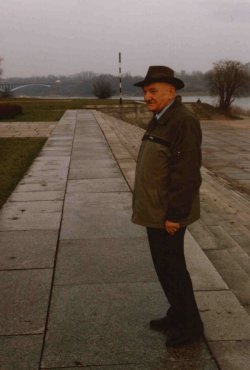
A retired brigadier Stanislaw Komornicki in Powisle by the Vistula; near the place, from which he set off to cross to the other side of the river. (26.11.2003; photo by Sz. Nowak)
He studied history at the University of Warsaw and graduated from Akademia Obrony Narodowej (the National Defence University). He worked at Wojskowy Instytut Historyczny (Military Institute of History). Because he was a soldier of AK, a politically non-alligned officer, a historian and a writer, he was discriminated and victimized. In 1957 he was dismissed from professional military service with the rank of a certified colonel.
In 1993 he was appointed as the Chancellor of the Order Virtuti Militari and commissioned brigadier. He died in a plane crash near Smolensk on April 10th 2010. On April 15th 2010 he was promoted posthumously to the rank of major-general.
Following in the soldiers of "Radoslaw" 's footsteps, 2nd assault platoon of 104th company of "Rog" Group, under the command of officer cadet "Nalecz", made its way to Czerniakow in the first week of September. The soldiers were assigned to "Tum" Battalion of "Kryska" Group and quartered in the building at 4 Idzkowskiego Street. Officer cadet Komornicki divided the platoon into three troops. He took command of one of them, the second one was under the command of corporal officer cadet Henryk Dolegowski "Haczyk" [Hook], and the third troop was led by senior rifleman Stanislaw Suski "Tarzan".
After a few days' break, in the middle of September, the Germans stepped up the pressure on Czerniakow due to changing position of the front from behind the Vistula, and attacked from three directions. The assault group of officer cadet "Nalecz" participated in driving the enemy back from Lazienkowska and Ludna Streets. Along with other assault groups of AK, AL (People's Army), and Slovaks, they defended the houses at Zagorna Street afterwards. Out of the whole platoon there remained only 13 soldiers.
Subsequently, the platoon defended the house at 4 Idzkowskiego Street from the Germans attacking from two directions: the infantry and tanks came from Zagorna Street, and other infantry units from the west trying to get through the courtyard to the rear of the house at 5/7 Idzkowskiego Street. On the orders of Major "Bicz" [Whip], officer cadet "Nalecz" and two insurgents crossed the river in the night of 15-16 of September 1944. They were to make contact with the Polish forces from behind the Vistula.
Stanislaw Komornicki "Nalecz" recalls: "The water was rising. The canoe was getting sunk quickly. We had to leave it. Wading in water, luckily shallow there, Jurek and I were carrying a wounded man who grew heavier and more numb every moment. The bullets were still buzzing but they ceased to be so pesky. The Germans were tormenting our empty canoe, which was flowing down the river, but we have already reached the riverbank. Suddenly, out of nowhere, a voice could be heard: 'Freeze! Who's there?!'. 'It's us, the insurgents', I replied and my heart started to beat faster. 'It's true', I thought, 'they're Poles."
When they got across to the other bank, the AK soldiers were taken to the command headquarters of 9 pp where they were questioned by the commander - Major Mierzwinski. They had to present him with the status quo and all the details they knew as well as to relate the information to a street plan of Warsaw. Next, as members of the crew with which Major Latyszonek crossed the river, they came back to the bridgehead.
This is how Satnislaw Komornicki recollects the preparations for the crossing: "Outside darkness fell already. The commotion on the coast increased even more. One could hear the creak of loaded wagons driving up to the exits of Walecznych and Zwyciezcow Streets, the sound of stamping feet hitting concrete paving as well as the clanking of cannons being shunted by the infantry. Everyone was talking in whisper. We went quickly past the groups of soldiers bustling about. On the other side of the embankment sappers were pushing boats and rafts out of the reeds growing at the edge of the extensive beach and move them franticly towards the river. Here and there we met civilians. They were the sand workers from the banks of the Vistula, the old sea scouts who had made their boats sank before, and they pulled them out again to prepare them for the crossing."
As soon as he returned and reported to Major "Bicz", officer cadet "Nalecz", accompanied by a group of soldiers from 2nd company under the command of Lieutenant Dolinski, was directed by Captain "Motyl" [Butterfly] to the house at 4 Idzkowskiego Street, to his original platoon. The insurgents received reinforcement in the form of an infantry platoon, 2 erkaems (light machine guns) and 2 armour-piercing rifles with handling included.
Lieutenant Dolinski took command of the whole group; however, at his request, every commanding officer of a platoon was to have at his side an insurgent whose task was to keep the lieutenant informed about what was going on and about the surroundings as well as to share the experience of fighting in the city, of which the soldiers had little knowledge. Within a night the house was transformed into a real stronghold. The windows were barricaded with bricks and arrow slits were included. The nearby barricade in Solec was strengthened and extended.
The stronghold at 4 Idzkowskiego Street was encircled. The Germans advanced from Zagorna Street and from the other end of Idzkowskiego Street. They were in the ultramarine factory too. The fire of German machine guns was coming from the charred ruins at Solec Street. The isolated insurgents and soldiers were at the end of their tether. Despair and lack of faith in the sense of further fighting grew in them.
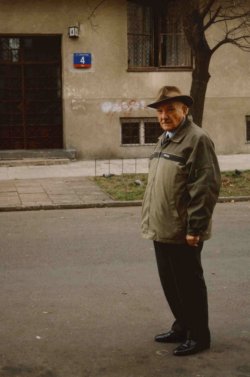
A retired brigadier Stanislaw Komornicki at 4 Idzkowskiego Street (26.11.2003; photo by Sz. Nowak)
"Nalecz" relates: "There's "Żyrafa" [Giraffe] in the bathroom. He can't see us. We are standing in the dark corridor and watching his every move with terror. He took a corpse with its head massacred by a bullet out of a bathtub and he is pulling off the dead man's jacket. He is doing this with quite an effort as the body stiffened long time ago. "Giraffe" comes up to the window and examines the checked jacked made from thick homespun cloth. It is stained with blood and its collar is caked with whitish brain mass. "Giraffe" is taking off his army camouflage and an armband. He's trying to use it to remove the brain mass from the jacket. He has a look of disgust on his face. You could see hesitation in his movements. He's thinking deeply. Eventually he covers the body with the jacket and grabs the armband. German voices are coming from the street. It's high time we got into our fire positions, but we cannot move. "Giraffe" freezes for a moment. He's listening closely. At last he grabs the jacket firmly and puts it on. He doesn't look back to catch a glimpse of the naked body but he just rushes to the door and bumps into us. We're standing still. We don't utter a word. "Giraffe" is looking at us with extremely big and bloodshot eyes popping out of his head. Suddenly he falls on his knees and sobs uncontrollably."
At night the soldiers managed to make their way to Solec, where the group of Cadet "Nalecz" was defending the last barricade remaining under control of the insurgents. This barricade was adjacent to the building at 1 Wilanowska Street where Captain "Jerzy" and Major Latyszonek were in command.
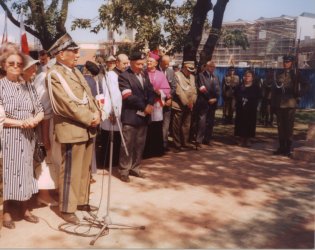
General Stanislaw Komornicki "Nalecz" makes a speech during the unveiling of the Commemorative Stone on "Radoslaw" Roundabout on August 10, 2004
The last hope for the combatants were radio announcements assuring them of evacuation to the other side of the Vistula.
"From the riverside escarpment you can see, in a glow of fire, the boats pushing off on the other side of the river. After a while the water surface was illuminated by the white light of German missiles. The air is filled with the rumble of cannons situated in Saska Kepa. The rattle of machine guns can be heard. Trails of tracers crossed over the surface of the Vistula. German mortar missiles are bursting dryly and they are splashing the water, which is transformed into fountains jetting high into the air. In the searchlight, whose glare was moving on water, soldiers are struggling desperately to overcome currents. Almost every boat is in the searchlight. Heavy machine guns and cannons are spraying them with bullets. The dreadful crying of injured men can be heard. Wrecked boats are plunging into a dark abyss. Single heads of swimming people crop up here and there. Only one boat reaches the bank we are on. It is extremely riddled with bullets and it starts drowning right by the riverside under the weight of people."
After an unsuccessful attempt to get to the city center Cadet Stanislaw Komornicki swam across the Vistula.
Maria Stypułkowska-Chojecka "Kama", a cadet corporal, during the Warsaw Uprising she served as an orderly and was a member of "Parasol" [Umbrella] Battalion. At present, she holds the rank of Capitain.
Maria Stypułkowska-Chojecka was born on September 24th 1926 in Warsaw. She joined ZHP (Polish Scouting and Guiding Association), Szare Szeregi (Grey Ranks) in occupation times, in 1937 and "Agat [Agate]-Pegaz [Pegasus]-Parasol" in 1943. She took part in operations of Mały Sabotaż (minor sabotage), and later on in combat missions organised by the battalion, these include e.g. Weffels, Fruwirth (Klein), Braun, Kutchera, Stamm, Hahn, Koppe (Cracow). She also took part in various trainings. She graduated from Szkoła Podchorążych "Agricola" ("Agricola" Cadet School), during the Warsaw Uprising she was a member of "Parasol" Battalion. The combat trail: Wola, Stare Miasto (the Old Town), Czerniaków, Mokotów, Sródmieście (the city center).
After they got to Powiśle Czerniakowskie, the soldiers were ordered to move to Zagorna Street, where they could wash themselves and take a rest. Then they were directed to the regions of Ludna, Okrag and Wilanowska Streets. "Kama" still remembers heavy fighting in Ludna Street and the moment when the Poniatowski Bridge was blown up. Subsequently, "Parasol" fought on gasworks grounds, where the group was almost cut off by the Germans. From there, "Kama" and her colleagues escaped to the side of Ludna Street with odd numbers of houses. However, because of further pressure exerted by the Germans the insurgents were forced to leave this position as well.
Maria Stypulkowska-Chojecka recollects: "I know that in the basement of the house we left there was Irena Szirtladze who begged me to kill her. Who could have done this? She asked me if I could tell her family what she has done. We were lucky. The Germans killed all the injured then. Our lives weren't all roses. It was more than bitter to know what could have happened to the injured."
It was at a barricade at Okrag Street when Maria Stypulkowska-Chojecka saw a Polish soldier with an odd-looking eagle on his cap for the first time. Everyone was overcome by joy and counted on further help from the army which was stationed on the other side of the river. At the same time Czerniakow began to receive airdrops of weapons, ammunition and food from the Russians.
"Kama" relates: "They dropped rusks, swinnoju tuszonku (pork spam), weapons and ammunition. The rusks made of brown bread were fine to eat after soaking; swinnaja tuszonka was nothing else than grease alone but it could be eaten if it came to the push; however, the weapon was useless, it was deformed, and the ammunition (caliber) didn't fit the pistols we used then. All the effort was in vain. We could only assess their good intentions and nothing else."
"Kama" also remembers the flights of American "Flying Fortresses" over Warsaw and the airdrops: "To make matters worse, most of the things that had been dropped fell into the Germans' hands, and it was not long after we found out that the Germans shot at us with grenade launchers made in Great Britain, because the number of darts was greater than the number in those produced by the Germans. They have used this drop against us... I remember legion melodies which were broadcast for us from the other side of the river - through megaphones. We were on our last legs when suddenly the sound of Polish military melodies struck our ears - a man doesn't feel hunger nor fatigue, but is full of hope and certain that they will come."
In spite of the hope and joy kindled by the arrival of the soldiers from 3 DP, the insurgents observed that Berling's men were prepared insufficiently for fighting in the city. "And we couldn't grasp why Berling's men didn't install the erkaems they brought with themselves. We needed that weapon." The rest of "Parasol" Battalion was ordered to move to defensive positions by the Vistula.
Maria Stypulkowska-Chojecka recollects: "I was given to go to the basements where the members of "Parasol" were and to tell them that we were going to fight for the bridgehead, for this piece of land, so that Berling's men could land there. I believed in this. I went and many (the majority of them were injured) responded by saying that they have no strength to fight, that they wouldn't go, that if Berling's men were to land, they could come there as well. The answers were varied. Few decided to go with us. In the building near the Vistula in Solec we waited out two nights or so."
In the night of 19-20 of September 1944 "Kama" together with a group of soldiers from "Parasol" made their way to Mokotow through sewers.
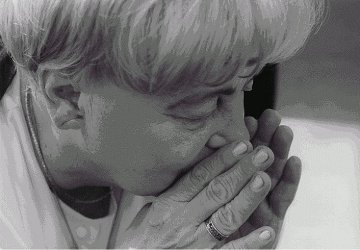
Maria Stypulkowska-Chojecka "Kama"
"We've heard we are to leave the building. It was night already. I left with an inner conviction that we were going to head for the riverbank, where we would wait for those who were going to land. I was very astonished to find out that we were moving towards the sewers. We went out onto the road. On the one side, they were raking from the bridge, from the Sejm hill, on the other side they were firing from Praga. Never in my life were I so scared. This whistle, explosions every now and then, the illuminated Vistula, the bank, the rockets being dropped, series of flares being fired. Warsaw was in flames, too. I pushed my friend away - I wanted to enter the sewer. She ("Zojda") said: 'Kama! Animal instinct must be controlled!' I looked at her and only then did I realize what I was doing. I didn't enter. I mean, I entered but only later. This animal instinct could be controlled. We set out for Mokotow. There we joined the fights. These were the last moments of Mokotow. "Radoslaw" - the commander of the group - made the decision to withdraw to Srodmiescie through sewers. We got out in Wilcza Street, at Aleje Ujazdowskie (Ujazdow Avenue), 18 hours later. The Warsaw Uprising surrender took place soon after."
Zbigniew Ścibor-Rylski "Motyl" [Butterfly] , a lieutenant, captain, a commander of AK "Czata 49" Battalion.
A retired brigadier, Zbigniew Dyonizy Scibor-Rylski, was born 10.03.1917 in Browki near Kiev. In 1920, when there was revolution in Russia, he and his parents moved to Poland. After he passed the secondary-school-leaving exam, he enrolled at Szkola Podchorazych Lotnictwa Grupy Technicznej (Cadet School of Aviation - Technical Group) in Warsaw, which he graduated from as a top student in 1939. He was assigned to I Aviation Regiment in Warsaw.
As a member of the regiment he began defensive battle against the Germans. In the second half of September he got to independent Group "Polesie" which was under the command of General Kleberg. He was assigned to "Olek" Battalion, in which he fought until 6.10.1939. After the capitulation he was taken prisoner and transported to stalag in Stargard. On July 1, 1940, along with a group of 30 friends, he broke free from the camp and after numerous adventures he reached Warsaw on September 1, where he made contact with the underground.
He was made a member of a cell which was responsible for receiving air drops. He received the drops himself in the area of Lowicz and Wyszkow Counties. On June 5, 1943, he was sent to Kovel in order to perform his task. After the concentration of 27 Volyn Division of AK, in January of 1944, he was promoted to the rank of a lieutenant and took command of a company in Lieutenant Fijalko "Sokol's" [Falcon] battalion. On July 15 he was summoned to Warsaw.
During the uprising he was a commander of a company in "Czata 49" Battalion. He covered the whole combat trail of "Radoslaw" Group. On August 17, 1944, he was promoted to the rank of a captain. At the time of the attempt to fight his way from Starowka to Srodmiescie he was a leader of a very bold plan according to which an assault group's aim was a sally through sewers and a landing through a hatch at Bankowy Square which was occupied by the Germans.
In the night of August 30, a 95-strong assault group under the command of Captains "Motyl" and "Piotr" [Peter], which previously belonged to "Czata", set off through sewers with the task to make a landing on Bankowy Square. The aim of the action was to commit sabotage at the German rear and to draw their attention from the major attacks organized in Stare Miasto. The expedition proved unsuccessful because a small group of insurgents was noticed too early and as a result some of them were shot (about ten or fifteen killed or injured men). Having been unable to get to the square, the rest of the group, including Captain Motyl, decided to make their way to Srodmiescie through sewers.
When on the bridgehead in Czerniakow, he was appointed the second in command of "Czata" Battalion; Major "Witold" was the commander. On September 17, Captain "Motyl" received the landing party of soldiers from General Berling's I Army of WP (Polish Armed Forces). In the night of 19-20 of September, although he was wounded, he and Lieutenant Colonel "Radoslaw" were to get through sewers to Mokotow, and after a few days to Srodmiescie. After the Warsaw Uprising Surrender, being wounded, he managed to get to Milanowek, where, until the liberation, he was engaged in underground activities.
A member of Komitet Budowy Pomnika Powstania Warszawskiego (the Building of Memorial Commemorating the Warsaw Uprising Committee), an organizer of "Czata 49" and Zwiazek Powstancow Warszawskich (Warsaw Insurgents Association), a chairman of the association for three terms, a member of Rada Kombatancka (Council of Veterans) in Urzad ds. Kombatantow i Osob Represjonowanych (Council for the Veterans and the Opressed).
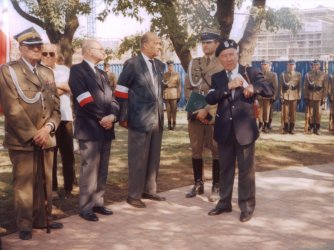
Colonel Zbigniew Scibor-Rylski "Motyl" (fourth from left) at the ceremony of the unveiling of the Commemorative Stone on "Radoslaw" Roundabout on August 10, 2004
In Czerniakow, Captain "Motyl" was in command of 2nd company of "Czata" Battalion, which got into positions in Ludna Street and took the outposts in the city's gasworks grounds. Zbigniew Scibor-Rylski received the landing parties of soldiers from 1st battalion of Lieutenant Kononkov. After the death of the lieutenant he took the command of 1st battalion, which was an unprecedented event as an officer of Polish Home Army was never before in command of a battalion which was a part of General Berling's Army.
A soldier of 3 DP, Tadeusz Targonski, recalls: "In a situation like this, Zbigniew Scibor-Rylski "Motyl", a captain of Home Army, is appointed a commander of 1st battalion of General Berling's Army. He was a handsome black-haired man with a pleasant look in his eye, and on his slightly soiled anorak there were medal ribbons of War Order of Virtuti Militari and Krzyz Walecznych (Cross of Valor) awarded for the participation in the Uprising. This kind of subordination concerning front-line sub-units of Polish Forces was the only one of this kind in our history."
In the night of 19-20 of September Captain "Motyl", along with "Radoslaw" Group, made his way to Mokotow through sewers.
Tadeusz Targoński, a corporal and a soldier of 3rd battalion of 9pp of 3 Romuald Traugutt DP.
A retired certified colonel, Tadeusz Targonski, was born 30.10.1926 in Glebokie, a county city in Vilnius Region, to the family of a technician working in the city's power station. After the II World War broke out, he graduated from primary school and passed the entry exam to the local gymnasium. He was active in a Cub Scouts group and subsequently in a scout troop of ZHP (Polish Scouting and Guiding Association) - Vilnius Regiment of Scouts. During the Soviet occupation, in the years 1939-41, he continued his study at the Russian ten-grade school completing fifth and sixth grades.
From the moment the occupation began, since September 1941, staying in the borderland of Lithuania and Latvia, he was active in a spontaneously formed unit fighting against the Soviet and German invaders. At the beginning of 1944 the unit transformed into 24th Dryswiacka Guerilla Brigade of AK. Towards the end of August in 1943, in the course of a combat mission in Nowy Pohost aimed at railway station, he was wounded in his leg by grenade shrapnels.
As soon as the Soviet forces entered again the Vilnius Region in July 1944, he was deported to Vologda, and then to Arkhangelsk. Having been forcibly inducted to the Red Army, he fought, among other things, in the ranks of 1178th regiment (of 350th infantry division) on the trail from Kiev, across the southern region of Poland, right up to sandomiersko-baranowski bridgehead by the Vistula. Towards the end of August 1944, with the rank of corporal, he was ordered to join the Polish Armed Forces.
As a member of 9th regiment of 3DP he took part in the fighting for warecko-magnuszewski bridgehead, in the Warsaw Uprising in Czerniakow district, in the action aimed at winning Kolobrzeg, the Battle of Berlin, as well as attempts to advance the Elbe River. At the end of the war he hold the rank of a second lieutenant.
He was transferred to the reserve in 1983. In the course of his long-lasting military service, he e.g. spent 27 years in the general staff of the Polish Armed Forces, including 20 years as the chief of 'zintegrowana dyzurna sluzba operacyjna' (Coordinated Duty Operations Service) of the Polish Armed Forces. During his military service he managed to graduate from the Officers' School of Artillery, Cywilna Oficerska Szkola Pozarnicza (the Civil Fireman Officers' School), Operations Faculty at the General Staff Academy of the Polish Armed Forces, he also completed a course in anti-nuclear defensive strategies at the Military University of Technology and a course in military defensive strategies and operations at the Postrgraduate School attached to the General Staff Academy.
After his transfer to the reserve, in the years 1983-89, he worked as an adviser to the civil defense and special operations manager in PHZ (an export-import company) "Polimex-Cekop" LLC in Warsaw. At the same time, since 1970, he has been active in managerial structures of various veterans' associations; first of all, in Ogolnopolski Klub Kombatantow (the Polish Veterans' Club) of 3rd Romuald Traugutt Infantry Division of Pomerania. He has been a chairman there since 1989.
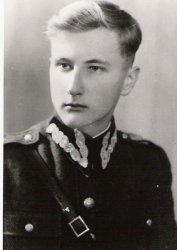
2nd Lt. Tadeusz Targonski (May, 1945)
Tadeusz Targonski was a soldier of the 3rd platoon of 9th company in 3rd battalion. Because he has already gained the experience in fighting as a soldier of the Soviet army, Lieutenant Stankiewicz made him a writer, a liaison officer and a commander of a battalion. This was his function during the fights in Czerniakow. He crossed to the bridgehead in the night of September 16, 1944, at 9 p.m., as a member of the 1st landing party of 3rd battalion of 9pp, in so-called 'czolowa fala' (advance wave).
Tadeusz Targonski relates: "With our palms spread wide, with a swing unprecedented, we make the sign of the Cross... An impatient signal sent by the commanders, and there we set off slowly. At the very last minute, one or two men, the elderly in particular, spit on their hands out of habit, as if they are going to work. And there they go. Our legs are buckling under the load of the boat. I am running in the first pair. The planks are damn badly biting into my shoulders. 'Hurry up, hurry up', urge the officers. But as if out of spite our legs are so unsteady. Right by the river somebody tripped and everyone, together with the boat, falls down in the sand. We block the people who are following us. Captain Olechnowicz swears in all languages he knows. Our boat, though we secured it meticulously, is making water dangerously under the excess load. Some soldiers are rowing furiously while others are getting rid of water using pots. Initially, everyone wants to hide somewhere under the water surface every time an explosion near us is heard, but later one becomes indifferent - there is only one thought: to move forward only, to be on the shore as soon as possible..."
And he continues: "Machine guns firing from the bridge region , whose flashes and whistling bullets paralysed us all, made a dreadful impression. We've been swimming for a long time. The boat was whirling with the main current. When the shore was near, we started to jump into the water reaching our knees as we wanted to find some shelter quickly. Lads taking part in the uprising gave a lot of assistance to us. They were much more poised than we were."
9th company got into the position at Idzkowskiego Street and in the area of the wire factory and the chemicals factory. Corporal Targonski's task was to maintain contact with the commander of 3rd battalion, Captain Olechnowicz, whose command post was located at 39 Solec Street. He was also to maintain contact with the Chief of Staff of 9pp, Major Latyszonek, after he had made a landing, because it was he who took command of all the forces of 9pp in Powisle Czerniakowskie. The dispatches brought by the liaison officer were often transmitted orally; sometimes they were written down in hand on a sheet of paper.
While a liaison officer was seeking out the addressee, he or she often joined the fighting not only as a member of his or her own company but also accompanying the subunits he or she was with at that time. "At some point, through the roar of explosions, I could hear clearly the growing clatter of caterpillar tracks, hoarse shouts of drunken Germans, and the Ukrainians rising to the attack along with them. Somewhere from Czerniakowska Street tanks are approaching us and right behind them the fascist with the sleeves of their uniforms rolled-up are advancing en mass. Their machine guns are spitting out bullets in short but quick series getting it, still changing the direction, at our defense. German utterances, sounding as they were barking 'vorwarts!' - forward, are mixing up with horrific and prolonged shouts of the Ukrainians "smert Lacham - rizaty!" which filled us with fear. I am aiming my "pepeszka" (PPSh submachine gun) carefully and from quite close up I am firing short series of 2-3 bullets right in the centre of the dense line formation of the attacking thug. After a while, a few of them fall kind of unnaturally and freeze. And although it's just their another attack, it all feels a bit strange."
During the fights 3rd battalion often fought in cooperation with the insurgent from subunits of "Czata 49" Battalion. In the course of the fights for every hall and room of the ultramarine factory, 9th company ceased to exist. The area of the bridgehead is shrinking violently, the rescue from behind the Vistula is not coming. The situation seems to be hopeless. There's shortage of ammunition and food.
The operations undertaken on the other side of the river, whose aim was to disburden and help those fighting in Czerniakow, including the landing of 8 pp between the bridges and of 7 pp to the south of the czerniakowski bridgehead in the region of Czerniakowski Peninsula, has ended in failure.
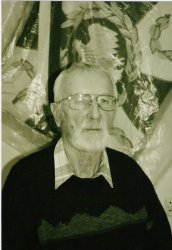
A retired certified colonel, Tadeusz Targonski, at the seat of Ogolnopolski Klub Kombatancki of 3rd Romuald Traugutt Infantry Division of Pomerania, against a background of the 3DP flag. (26.03.2004; photo by Sz. Nowak)
In the night of 19-20 of September, a vast part of insurgent units withdrew through sewers to Mokotow. The injured commander of 3rd battalion, Captain Olechnowicz, was evacuated to the right riverbank on September 21. That day in the course of defensive action the commander of 3rd company, Lieutenant Stankiewicz, died at 9 Idzkowskiego Street. Some of the soldiers were taken prisoners. A crowd of civilian women were pestering Major Latyszonek to withdraw the forces behind the Vistula or to surrender to the Germans who airdropped leaflets calling for the surrender.
The house at 1 Wilanowska Street is in flames. There are no more companies or battalions; instead combat units consisting of soldiers and insurgents are fighting. At the same time, ammunition is running out. That being so, extremely exhausted and injured soldiers decide spontaneously to swim across to Praga.
Tadeusz Targonski recollects: "Our epic full of blood came to its end. We were well aware that nobody was going to help us anyway. In front of us entire Czerniakow was ablaze, right behind us there was the dreadful Vistula. As much as possible we loaded carefully only the most seriously wounded soldiers and, as usually, a few women and children to the boats, which were few in number. I checked the number of the bullets for my pepeszka - there was 15 of them. It was a lot and yet nothing. When at some moment I heard the dull sound of the lock. I knew my fight was over. I looked to the left, then to the right, and furtively, so that nobody could notice my weakness, I kissed her and hid her carefully in the waterside rubble. My shabby and as much battered as myself loyal sister in arms. When I cast my last glance at smouldering Czerniakow, the tears as large as peas ran down my cheek. Maybe it was because of the smoke trailing all around, or because of the thought that all the casualties and the great sacrifice, that all effort was in vain. Next I took off the shreds of my uniform and my shoes - I hadn't any underwear as it was used as bandages long time ago - and in pants alone I went into frightfully ice-cold water. (...) Every time I heard the explosion I choked perilously in water and started to sink. Having summoned up the last reserves of energy, I was desperately swimming towards salutary shores of Praga - to my friends as I felt such a great desire to live."
Tadeusz Targonski swam across the Vistula on September 22, 1944. He was accompanied by friends from his combat group (companies, platoons, even squads no longer existed). They made it at dusk as it is the darkest moment and later light grows and everything that happens on the water surface can be noticed easily. He was injured by an explosion of a mortar projectile after he reached the right shore.
Czeslaw Zaborowski "Cesiek", "Lalka" [Doll], "Zabor", a senior rifleman, a corporal, a soldier of "Miotla" [Broom] Battalion of AK.
A retired lieutenant-colonel Czeslaw Zaborowski was born on February 29, 1928. He is an automotive electronics engineer by education. When the uprising broke out, he was a student of Michal Konarski Technical College. During the occupation he was an active scout in the underground. In the course of the uprising he covered the combat trail of "Miotla" Battalion: Wola, Stare Miasto, Czerniakow. He left the building of Panstwowa Wytwornia Papierow Wartosciowych (the State Concern of Securities Issue), which was called the bastion of Starowka, as one of the last defenders on August 28, 1944.
After heavy fights in Czerniakow, where he was wounded, he was taken prisoner from the half-sunken boat "Bajka" [Fairytale] by the Germans on October 2. He landed in prison at Sokolowska Street but he escaped to join the guerilla troops in Bolimow Forest.
In the autumn of 1945 he joined the People's Army of Poland. He returned from the war with the rank of corporal. In 1946 he was accused of the attempt "to stage a coup". After six months he left prison without sentence.
He had a job building the W-Z road. In February of 1950, he was conscripted to Piaty Batalion Pracy (5th Battalion of Work) in a coal mine.
Then he has been working in Dzial Interwencji (Intervention Department) of ZboWID (Society of Fighters for Freedom and Democracy) for many years (he investigated from 32 to 34 000 cases concerning veterans yearly). Afterwards he worked in the department for veterans in the personnel office in Ministry of Defence.
He devoted a lot of energy to retain memory of Warsaw insurgents. He participated actively in the reconstruction of 24th plot of "Miotla" Battalion in Powazki Military Cemetery. He was also active in Klub Kawalerów Orderu Wojennego Virtuti Militari (Knights of War Order of Virtuti Militari Club).
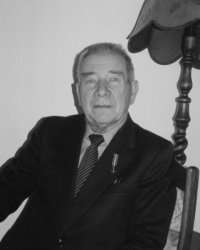
A retired lieutenant colonel, Czeslaw Zaborowski, in his house in Warsaw (13.02.2004; photo by Sz. Nowak)
Czeslaw Zaborowski got to Powisle Czerniakowskie together with "Miotla" Battalion in the night of 3-4 or 4-5 of September. During the initial phase of the stay in Czerniakow, as a result of reorganisation of subunits, Captain "Zgoda's" sapper group under the command of lieutenant "Sarmak" was formed. Czeslaw Zaborowski's immediate superior was Sergeant "Slepowron".
The same evening they were quartered at 12 Wilanowska Street, the sapper group was ordered to dig out all the men buried at 3c or 3d Okrag Street. Next they dug a ditch at 5 Okrag Street (the corner of Ludna Street). To solve the problem of hunger "Cesiek-Lalka" and his colleagues made trips to the allotments by the Vistula. They brought potatoes, tomatoes, cauliflowers and cabbages from there.
During the first of such excursions "Blyskawica" [Lightning] - Tadeusz Bednarek - attacked the German police station with a grenade. On September 13, 1944, the unit was ordered to dig a communication trench between 14 and 18 Wilanowska Street. Due to heavy fire only up to three men in a leaning position could do their job. One soldier was killed by a grenade and three others were wounded, including Czeslaw Zaborowski.
At that time the area under control of Poles was shrinking violently and there was this impression that the number of defenders grew. The quarters of Czeslaw Zaborowski's unit were located at 12 Wilanowska Street. The building was prepared for the defense - sacks with sand were laid down in the windows so that embrasures were created. The first German attacks were fought back. The insurgents got the news that Polish Armed Forces were about to make a landing at night to help Warsaw. Czeslaw Zaborowski recollects: "The shift came in the morning and we withdrew to the front staircases - number 12 and 14. I remember the liaison officer came running with the dispatch saying that Polish Armed Forces were making a landing to help Warsaw. She even distributed some candies which she held in a haversack. An incredible joy ensued. Finally we were going to have weapons to fight. She jumped out onto the road but she didn't manage to join the rest, and almost in front of our very eyes she fell flat on her face having received a fatal shot. Almost everyone cried."
After the soldiers from Berling's Army crossed the river, hope was mixed with astonishment, which was caused by a large number of wounded Berling's men. It turned out that the soldiers were not trained to fight in the city and it could be noticed during the fighting in czerniakowski bridgehead. After the withdrawal from the building at 12 Wilanowska Street, the Czeslaw Zaborowski's unit defended the house at 5 and 5a Wilanowska Street. The commander of the platoon assigned "Cesiek-Lalka" to pass the ammunition to a Berling's man handling a cekaem(a heavy machine gun). Numerous German assaults and tanks were repulsed. A great assistance in maintaining the insurgent's positions was provided by the artillery firing from behind the Vistula.
When the remainder of the unit, which was under "Blyskawica's" command, withdrew, the next and last at the same time point of resistance was the building at 53 Solec Street. The insurgent "Lalka" recounts: "In the morning of 23rd (probably the ceasefire which took place in the morning of September 22nd is mentioned here) fell a sinister silence. We were wondering what had happened. It was "Blyskawica" who explained that a German delegation was sent and they called a ceasefire. Actually, a moment later we could see civilians, Berling's men, the wounded carried on doors moving along Solec and turning into Wilanowska Street. I remember well that in our quarters an elderly woman, who lived or just stayed there, gave me a prayer book and asked me to pray for her as she would not survive. I thanked her. She kissed me and, walking with a stick, joined the column. When I was looking at the column moving slowly, I was astonished by the large number of civilians and soldiers. Where did they come from? As they were leaving the battle field, or it would be better to call it a patch of land where the fighting took place, they made a horrible sight; plenty of them were crying and wailing. They marched slowly as if they were in a funeral procession. It was a strange parting with the walls which were close to some of them for sure. But then they left into the unknown, like wanderers."
The Germans made use of the confusion and despite the ceasefire they tried to take the defenders at 53 Solec Street by surprise but the attempt proved unsuccessful.
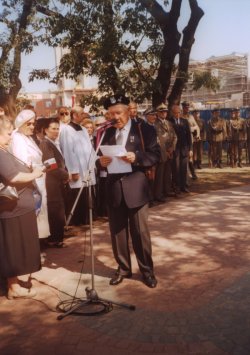
Lieutenant Colonel Czeslaw Zaborowski, an initiator of the monument construction, makes a speech at the ceremony of the unveiling of the Commemorative Stone on "Radoslaw" Roundabout (10.08.2004)
When they received the message that the evacuation would take place that night for sure and that they would bring boats, the group went close by the Vistula. But the aid did not come and "Blyskawica" decided to get to the half-sunken boat "Bajka".
Czeslaw Zaborowski relates: "There was about 10 of us when we headed for "Bajka". People tried to swim to Praga using anything they could. The Germans were squeezing bursts from grenade launchers towards the Vistula. It was a rain of grenades, an explosion every now and again and fountains went upwards. It grew light already. "Blyskawica" and I grabbed a pillar and we started swimming. The rain of grenades was coming down from the turrets of the Poniatowski overpass. Fire from machine guns. Our legs were seized with cramps. We got back. The pillar carried me to "Bajka" somehow, and if Berling's men had not pulled me out, I would have been drowned for sure. I did not find neither clothes nor shoes. We had to undress the dead, and having worn a military coat I found a place on a rudder blade. I mean, we laid down planks and we could have a rest while sitting. On the board there were injured men. They were groaning. A horrible sight." According to Cz. Zaborowski there were about 50 people on the boat at that time, a second lieutenant - Berling's man - among others. Apart from that there were idle radio stations, a host of weapons and ammunition. The dead men were removed into water. Food was obtained somewhere in Zagorna Street and there was plenty of drinking water in the Vistula. It was better, however, if it was drawn in front of "Bajka".
The soldier "Miotla's" memories of the last days: "In the evening a canoe with a warrant officer, a sergeant and a sapper pulled in to "Bajka". They came to take Major Latyszonek; they were ordered to bring him to Praga dead or alive. Nobody knew what happened to him. The last time he was seen was at 1 Wilanowska Street. The soldiers who arrived to take Major Latyszonek went in search of him but they did not come back. In the three subsequent nights a boat pulled in to "Bajka" and took two injured men. Every time they inquired after Berling's men and Major Latyszonek."
Some people, there was about ten of them, made an attempt to get to the other side of the Vistula through spans of the Poniatowski Bridge which was blown up previously. But the Germans opened fire from machine guns and grenade launchers on them. Only a very few people managed to get to the other side in this way. Czeslaw Zaborowski recollects: "It was on October 2 and it was already dark. Three civilians came to "Bajka with their hands up ". The man who was on duty stopped them and brought them to the second lieutenant whom we treated as our commander. They said they were Poles working for the Germans as grave- and fortification diggers, and they were sent by the Germans so that we surrendered because in half an hour "Bajka" would be blown up, and that it would be absolutely meaningless, that the whole Warsaw has already surrendered, that we would be treated properly, that "Bajka" was surrounded. The second lieutenant organised a briefing, no one, however, wanted to take the floor. Only a few of the elders said that in such a situation an attempt to defend ourselves was aimless and we ought to surrender. No one tried to protest."
The soldiers and insurgents from the ship "Bajka" were taken prisoners only on October 2, 1944.
PS
In the course of collecting materials for M.A. paper "Czerniakowski Bridgehead and Its Soldiers" , which was defended in 2005 under Prof. Tadeusz Rawski's direction, I met personally a group of the insurgents and soldiers of I Army of WP who participated in the fighting in Upper Czerniakow during the Warsaw Uprising in 1944.
I decided to introduce their stories to the readers of Stowarzyszenie Pamieci Powstania Warszawskiego 1944 website. They are a testimony to hard and complicated times which affected Polish patriots fighting for liberation of our homeland from the violence used by the Nazi occupant. It is also probably the only case of military cooperation between AK soldiers, the insurgents of Warsaw and the soldiers of General Berling 1st Army of WP.
At the beginning of 2011 the publishing house 'Inforteditions' is planning to publish my paper "Czerniakow Bridgehead 1944".
The photos come from the collection of author, Janiny Wolanin née Blaszczak, Marii Stypulkowskiej-Chojeckiej, Tadeusza Targonskiego, Czeslawa Zaborowskiego.
compiled by Szymon Nowak
edited by Maciej Janaszek-Seydlitz
translated by Sabina Decowska
Bibliography:
1. Baczko Henryk "8 dni na lewym brzegu", Warszawa 1946;
2. Ciosk Anna "Janina Wolanin. Honorowy Obywatel miasta Zielona Góra", "Pionierzy" czasopismo społeczno-historyczne, Zielona Góra grudzień 2003;
3. Grigo Tadeusz "Powiśle Czerniakowskie", Warszawa 1989;
4. Kaczyńska Danuta "Dziewczęta z Parasola", Warszawa 1993;
5. Komornicki Stanisław "Na barykadach Warszawy", Warszawa 1981;
6. Komornicki Stanisław "W pułapce losu", Warszawa 2004;
7. Margules Józef "Przyczółki Warszawskie", Warszawa 1962;
8. Niżyński Leszek "Batalion Miotła", Warszawa 1992;
9. Sieczkowska Agnieszka "Za żywota byłem w piekle. 59 rocznica upadku powstańczej Wytwórni", "Życie Wytwórni" Tygodnik Polskiej Wytwórni Papierów Wartościowych S.A., Nr 32, 28 sierpnia 2003;
10. Stypułkowska-Chojecka Maria "Kama" Wspomnienia, spisane przez autora w dniu 17.04.2005;
11. Targoński Tadeusz "Kresowiak na Czerniakowie", "Gazeta Wyborcza Stołeczna", 21 września 2004;
12. Targoński Tadeusz Wspomnienia, maszynopis i rękopis;
13. Wolski Andrzej "Jur" Wspomnienia z Czerniakowa, http://wilk.wpk.p.lodz.pl/~whatfor/wspom_wolski_jur_czer1.htm;
14. Zaborowski Czesław Wspomnienia, rękopis;
Copyright © 2012 SPPW1944. All rights reserved.